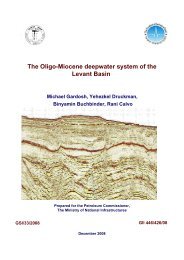The Geology of the Elat Sheet Explanatory Notes
The Geology of the Elat Sheet Explanatory Notes
The Geology of the Elat Sheet Explanatory Notes
You also want an ePaper? Increase the reach of your titles
YUMPU automatically turns print PDFs into web optimized ePapers that Google loves.
grain- size with lateritic beds. <strong>The</strong> Kurnub Group is <strong>of</strong> alluvial origin and forms <strong>the</strong> s<strong>of</strong>t<br />
geomorphological unit below <strong>the</strong> carbonate cliffs <strong>of</strong> <strong>the</strong> Judea Group. <strong>The</strong> Kurnub Group<br />
outcrops along <strong>the</strong> margins <strong>of</strong> Mt. Amram, Nahal Shani, sou<strong>the</strong>rn Mt. Shehoret, along<br />
Nahal Netafim and north and south <strong>of</strong> Nahal Gishron.<br />
During Late Barremian-Albian times <strong>the</strong> sou<strong>the</strong>rn margins <strong>of</strong> <strong>the</strong> Tethys Sea transgressed<br />
over <strong>the</strong> Arabian-Nubian continent in pulses evidenced by shallow marine sediments in<br />
between terrestrial clastics. Since <strong>the</strong> Early Cenomanian <strong>the</strong> sea covered <strong>the</strong> <strong>Elat</strong> region<br />
and gradually progressed southwards into Sinai (Egypt).<br />
3.2.3 <strong>The</strong> Judea Group <strong>of</strong> Cenomanian-Coniacian age comprises four marine<br />
formations: Hazera, Ora, Ger<strong>of</strong>it and Zihor which were described by Bartov et al. (1972).<br />
<strong>The</strong> Hazera Formation, which is 120 m thick, is divided into four members which are<br />
mappable at <strong>the</strong> Mt. Amir syncline. <strong>The</strong> lower Hevyon Member forms a light brown<br />
dolomite cliff 30 meters thick with an up to 10 m thick yellow glauconitic-dolomitic-<br />
sandstone bed at <strong>the</strong> base unconformably overlying <strong>the</strong> Samar Formation. <strong>The</strong> En<br />
Yorqe'am Member, 30 m thick, is built <strong>of</strong> a green marl and clayey limestone rich in<br />
bivalves, gastropods and echinoderms. <strong>The</strong> gray limestone with chert nodules and<br />
Nerinea <strong>of</strong> <strong>the</strong> Zafit Member forms a 30 m high cliff. <strong>The</strong> double cliff <strong>of</strong> <strong>the</strong> lower<br />
Hevyon Member and <strong>the</strong> upper Zafit Member with <strong>the</strong> marly En Yorqe'am Member in<br />
between is an important marker for geological mapping. <strong>The</strong> assignment <strong>of</strong> <strong>the</strong> members<br />
<strong>of</strong> <strong>the</strong> Hazera Formation described above and shown on <strong>the</strong> map assumes a particular<br />
correlation with <strong>the</strong> type section <strong>of</strong> this formation. However, ano<strong>the</strong>r correlation is also<br />
possible. <strong>The</strong> section in <strong>the</strong> <strong>Elat</strong> area may also be interpreted to comprise only <strong>the</strong> Zafit,<br />
Avnon and Tamar members (i.e what is shown as Hevyon may actually be <strong>the</strong> Zafit<br />
member, etc.). More study is needed to resolve this uncertainty.<br />
<strong>The</strong> upper Yotvata Member is built <strong>of</strong> white to gray well-bedded limestone at <strong>the</strong> lower<br />
parts, paper limestone at <strong>the</strong> middle and white limestone with <strong>the</strong> ammonite Neolobites<br />
Vibrayeanus indicative <strong>of</strong> <strong>the</strong> Late Cenomanian. A thin red-brown limonitic-dolomite<br />
bed at <strong>the</strong> top <strong>of</strong> <strong>the</strong> Yotvata Member marks <strong>the</strong> top Hazeva Formation. During <strong>the</strong> Late<br />
Cenomanian-Early Turonian elongated shallow basins striking nor<strong>the</strong>ast-southwest<br />
developed in <strong>the</strong> Negev (Freund, 1962). <strong>The</strong> biggest basin is in <strong>the</strong> <strong>Elat</strong> area with a water<br />
depth <strong>of</strong> 50 to 100 m where <strong>the</strong> Ora Formation (previously called Ora Shales) was<br />
deposited. <strong>The</strong> basin was situated between <strong>the</strong> coast to <strong>the</strong> south and <strong>the</strong> elevated<br />
carbonate platform belt (Ramon-Judea) to <strong>the</strong> north. Relative sea-level fluctuations<br />
temporarily turned <strong>the</strong> basin into a lagoon with brackish-water during influx <strong>of</strong> run<strong>of</strong>f<br />
water with plants, or hypersaline conditions depositing dolomite and gypsum. <strong>The</strong> Ora<br />
Formation is up to 108 m thick and is divided to three members: <strong>The</strong> lower member is<br />
build mainly <strong>of</strong> green to gray shales with gypsum veins and thin beds <strong>of</strong> yellow nodular<br />
limestone with Early Turonian ammonites. <strong>The</strong> middle member is known as <strong>the</strong><br />
fossiliferous dolostone Vroman Cliff in <strong>the</strong> Makhtesh Ramon area. Among <strong>the</strong> common<br />
fossils are <strong>the</strong> Turonian ammonite genus Ch<strong>of</strong>faticeras and <strong>the</strong> gastropod Tylostoma<br />
Cossoni <strong>of</strong> Early and Middle Turonian. <strong>The</strong> upper member is built <strong>of</strong> red and green beds<br />
<strong>of</strong> shale, a 5 m thick massive gypsum bed and thin beds <strong>of</strong> limestone and dolostone. <strong>The</strong><br />
s<strong>of</strong>t morphology and <strong>the</strong> red and green shales with <strong>the</strong> gypsum bed are good mapping<br />
markers. Complete sections <strong>of</strong> <strong>the</strong> Ora Formation are found at Nahal Shelalgon, <strong>the</strong><br />
eastern part <strong>of</strong> Nahal Shani, at <strong>the</strong> axis <strong>of</strong> <strong>the</strong> Mt. Amir syncline and north <strong>of</strong> Maale <strong>Elat</strong>.<br />
Along some faults <strong>the</strong> shales like at upper Nahal Shelomo, Nahal Shani and between<br />
Nahal Gishron and Nahal Yehoshafat are folded into diapir structures as a result <strong>of</strong><br />
faulting along <strong>the</strong> margins <strong>of</strong> <strong>the</strong> Dead Sea Transform and <strong>the</strong> <strong>The</strong>med Fault. West <strong>of</strong> Mt.<br />
Amram <strong>the</strong> shale <strong>of</strong> <strong>the</strong> Ora Formation comprise <strong>the</strong> lubricant for <strong>the</strong> eastward sliding <strong>of</strong><br />
5

















